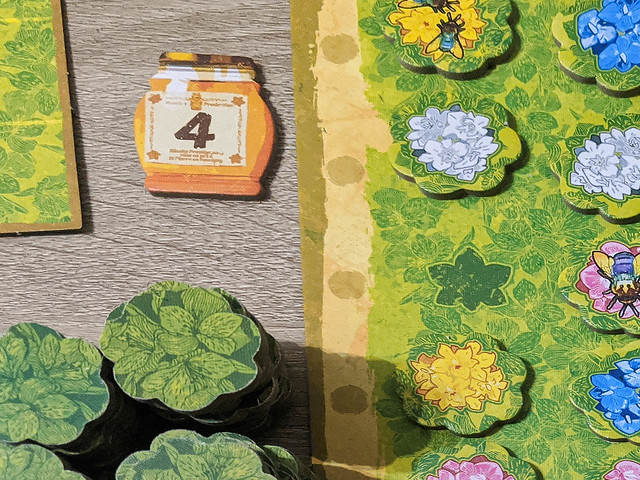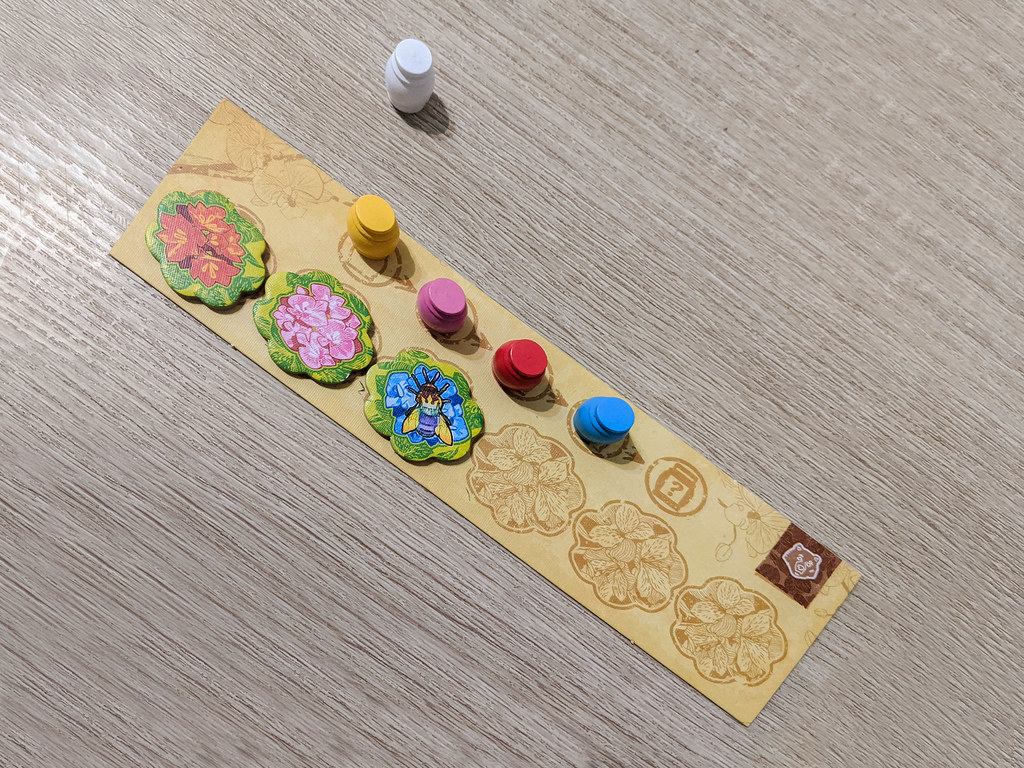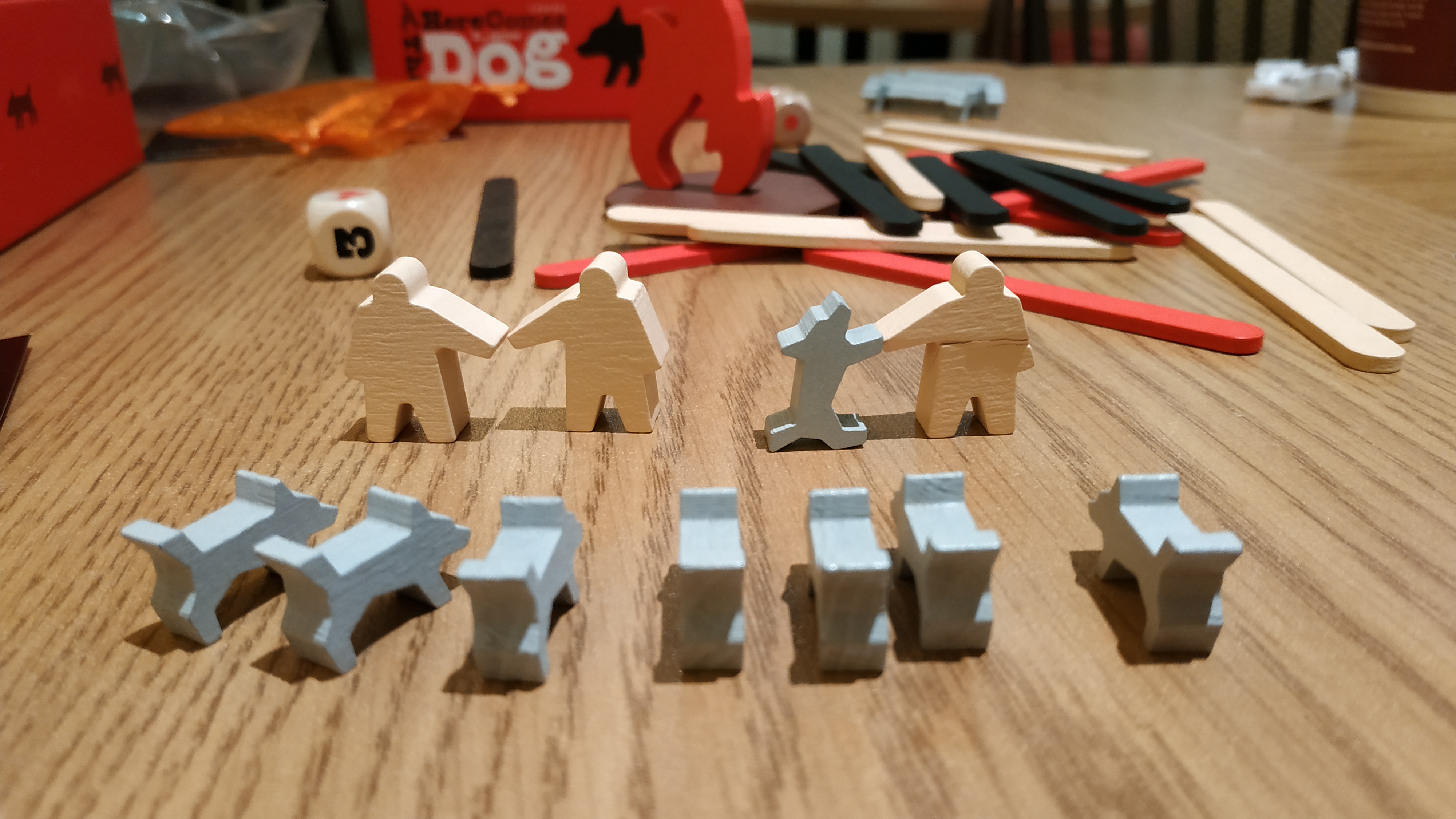Queenz: To bee or not to bee (or we’ll shorten it as Queenz for the rest of this article) is a board game published by Mandoo Games and Rio Grande Games. This is not the first time we are honoured to review the game from Mandoo Games. From last year’s Spiel Essen (2018), we also reviewed three of their games: Wangdo, Spring Rally, and Seals. My personal overview towards their games is always positive and this year, I am excited to review Queenz, too.
Bruno Cathala and Johannes Goupy are the designers of this game. Meanwhile, Vincent Dutrait, the French artist, is in-charge with the artwork. Let’s take an in-depth look to Queenz!
An overview
Queenz is a quick game for 2-4 players. In this game, the players are beekeepers that compete to gain points through blooming fields and gathering bees to produce honey. It is a quick game because we only need approx. 30-40 minutes to finish a game.
There is a big Garden board in the middle with orchid tokens randomly shuffled and placed across the garden. The rest of the orchid tokens are set aside near the Garden board, ready to refill when we trigger the condition. Each of you will also get the player board. It is essentially your personal supply for the orchid tokens you gather later to bloom your field. You will also spot 5 honey pots in different colours and 3 hives for each player, 4 diversified honey tokens with different values, a Scoring track board, and several Field tiles.

How to play Queenz
Players play Queenz in turn. The first player is chosen randomly and he/she may put the Gardener pawn wherever he/she sees fit. During your turn, you can choose between taking one or more orchid tokens and blooming a field.
Taking orchid tokens
If you choose to take orchid tokens, there are some rules you should know. First, you can only take the orchid tokens from the row/column of the Gardener. Second, you may take 1 orchid token with/without bees on it, or you may take any 2 tokens without bees, or you may take 3 tokens without bees with all different colours. Then, put them on your player board’s supply. Last but not least, move the Gardener pawn as many steps as the tokens you have taken clockwise.
Blooming a field
If you decide to bloom your fields, you take one of the available fields and you must fill all the squares with the orchid tokens from your supply and/or the hives. You will also gain a point for each from the honey colour you create or enlarge, as long as there are 2 orchid tokens of the same colour. If it’s your first time to place that orchid colour, you also place the honey pot of that colour on your board.
Other rules in Queenz
If you find an orchid token with only one bee on it, it is the Queen Bee. When you take this token to your supply, you may swap it immediately with any token on the field.
Also, only refresh the field tiles and the orchid tokens when the refreshing conditions are triggered. You must refresh the field tiles when you take the last field tile available (there are 5 tiles, to begin with). The orchid tokens are also refilled when you move the Gardener to an empty column/row. Both of them will be refilled when the Gardener goes past the red arrow. Whenever you do this, you also gain 1 point.
End-game and scoring

Whenever a player puts his/her last honey pot, he/she will gain the diversified honey token. This will contribute different points at the end of the game. The game ends when a player blooms his fifth field. All players will take their last turn; everything goes normally except when you decide to bloom a field, you don’t have to fill all the squares on it.
After the game ends, calculate all points from what you have gained plus the diversified honey token you got.
You also have to add the points you gain from the hive. Each hive will contribute 1 point for each bee on the squares surrounding it. Whoever gains the most points win the game.
Opinions & thoughts
Queenz really gave us great times during our gameplay. For sure Bruno Cathala has once again produced gold. This might be another mainstream board game from him.
First impressions on everything
Greenish cover with the big yellow orchid and concealed bees on the cover did not really have an eye-catching profile at first. The components inside were the one that gave the impression that Queenz would be interesting to try. There are a lot of tokens and I was like getting this feeling that Queenz would have a bunch of aspects we have to take care of during the gameplay (and I was not wrong).
The components
Just like I mentioned, there are a lot of components in Queenz. I love how they thickened the cardboard orchid tokens. It gives the robust vibe; perhaps they really strengthened the orchid tokens due to the shuffling and grabbing it will suffer. Meanwhile, the other tokens are just normal, so-so quality but still bearable and will never be a major threat to the fun Queenz may offer. On a side note, the components are colourful, too.
The gameplay
Queenz has a set collection (from the orchid picking) coupled with tile laying mechanic (blooming the field). Both mechanics are really important in the gameplay mainly to maximise the points you can score during the gameplay. It has a strategic touch although mainly you should think more tactical, adapting to what the other players currently doing.


Decision-making is the focal point in Queenz because there’s more than one way to win the game: you can expand and bloom the same colour or spreading the bees and build the hives, or you can also plan to gain the diversification bonus points. Taking all the same flowers will help you to bloom the field faster. However, sometimes it is also worth it to have patience and take the bees, scoring more points later on.
While taking this into account, you should also mind what you give to your opponent. If you take x amount of flower(s), then the gardener will move x step(s); will you be too generous to give the flowers your opponent needs?
By the way, the latter point mentioned above is the only player interaction I could find in Queenz, though. It’s closer to the Zen-gaming type where each player is busy with his/her own player board. This does not mean that it’s a faulty game, no. If you like this kind of solitary game, Queenz would be a good addition in your armoury.
Verdict
Queenz: To bee or not to bee is a light, fast-paced board game that would be fun for all type of board gamers. It’s also about bees and orchids, and honey. Thematically, it’s interesting (subjectively, of course). Either you are normies or veteran, you will find this a delight. I would recommend all players to try Queenz.
I am a full-time food technologist during weekdays. However, when the calendar hits weekends, I transform into an avid board gamer. I am a hardcore Legend of the Five Rings (L5R) LCG player from Fantasy Flight Games (FFG). Current hobby: buying board games. My shelf of shame’s list is getting longer, thanks to you, Kickstarter.





